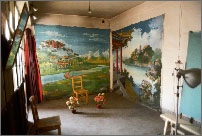April 26, 2011
Wild Flavor
If you are interested in food, endangered species, epidemiology, or modern China I recommend seeking out Karl Taro Greenfeld's 2005 Paris Review essay on Guangzhou's 'wild flavor' bush meat restaurants. An excerpt:
Now this style of dining, which was once a quaint local custom, had become industrialized. In one cage at Xinyuan I counted fifty-two cats packed so tightly that their guts were spilling out between the wire bars. There were fifty such cages in that stall. There were fifty-two stalls along that row of vendors. There were six rows of vendors in that market. And there were seven markets on that street. A sharp, musky smell overwhelmed me—the excrement of a thousand different animal species mingling with their panicked breath. I saw at least a dozen types of dogs, including Labradors and Saint Bernards, and there had to be at least as many different breeds of house cat. There were raccoons, dogs, badgers, civets, squirrels, deer, boars, rats, guinea pigs, pangolins, muskrats, ferrets, wild sheep, mountain goats, bobcats, monkeys, horses, ponies, and a camel out in the parking lot. And these were just the mammals. The choice of birds and reptiles was every bit as diverse. Predator was sometimes stacked atop prey. Damaged animals—those that had lost a paw, say—were kept alive with intravenous drips. And because wild animals were more valuable than farm-raised creatures, I was told that some traders would slice off the hind paw of a civet or badger to make it appear to potential buyers that the animal had been trapped in the wild.I had brought a list of banned animals from the Wild Animal Protection Office. I asked for the rare bird species, the monkeys, the tigers.
“No problem,” I was told by a smiling trader with buckteeth who said he was from Guangxi.
“What about the authorities?” I asked.
“No problem.” He pointed to a fellow in a gray and blue uniform sitting on a white plastic chair, flicking his cigarette ashes by a bag of banned snakes.
“OK, how about mountain lion?”
“No problem.”
“Black bear?”
“No problem.”
I decided to push my luck.
“How about panda?”
He shook his head. “You must be sick.”
The entire article is available in this back issue of the review, as a chapter of the excellent
The Best Creative Nonfiction, Vol. 1, and as a portion of China Syndrome: The True Story of the 21st Century's First Great Epidemic (which I haven't read but plan to!).



Add your thoughts: